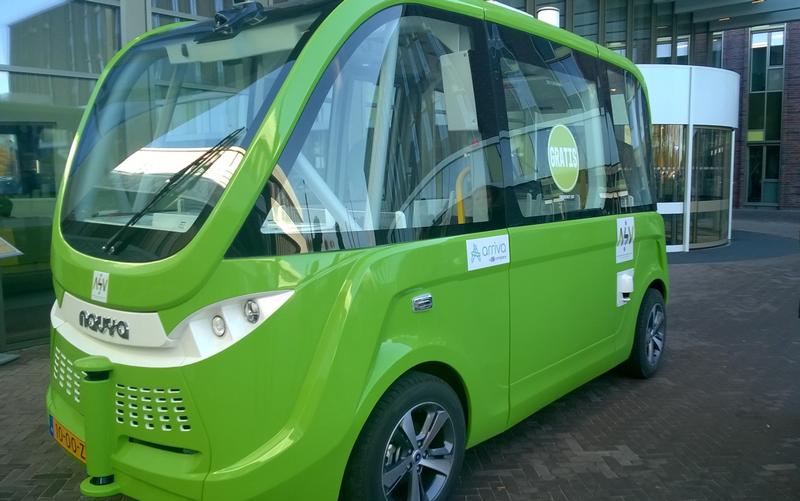
Image Credit: Donald Trung Quoc Don (Ch? Hán: ???) - Wikimedia Commons
The art of automation and the incredible technologies humans have been able to create have been absolutely mesmerizing throughout the past few decades. While the flying car hasn’t quite been perfected yet, self-driving technology is rapidly advancing and becoming more available to consumers. One can argue that this began with cruise control and has evolved into other things like lane assist and crash detection braking, but the transportation industry is expected to continue booming technologically and this may expand into self-driving school buses.
Various companies have begun coming up with possible designs for self-driving school buses, which includes Seattle-based design firm Teague. Teague has created the concept of “Hannah,” which is the name for its “conceptual reinvention of K-8 transportation that illuminates the operational, financial, and even social innovations within an entirely new approach to student transportation in the age of autonomy.” “Hannah”s would have the ability to move back, forth, left, and right and carry six students at a time while stopping immediately in front of every child’s house so that no child has to cross the street (which is oftentimes dangerous).
Volkswagen might also want a piece of the self-driving school bus industry, unveiling its “SEDRIC'' model in 2018. The company may eventually offer this vehicle to schools and others, including senior citizens and mobility-impaired groups. Volkswagen states that the vehicle “comes to its passenger when summoned with the push of a button, navigates traffic, and makes all its own decisions.”
Self-driving school buses would certainly be an intriguing new concept for engineers, who would have to come up with even more reliable school bus management software in order to make sure routes run smoothly. School bus GPS tracking systems would also have to be improved drastically, seeing as there would be no driver to make quick decisions or let anyone know where the buses are or if there are issues. Of course, many parents and students enjoy today’s school bus GPS tracking, but self-driving buses would likely need more reliable technologies with more features.
Self-driving school buses may also benefit parents, as it would be expected that school bus routing apps would also have school bus stop finders and school bus notification systems to alert them of any delays or route diversions. Human communication with the buses would still be critical and it is likely buses would have cameras that humans could monitor remotely to observe the children and surroundings for any problems. Many people think of autonomous vehicles as just “driverless,” but while they do not have a physical driver, they remain extremely connected to humans and manmade technologies.
School bus scheduling software is also likely to transform greatly if self-driving buses begin operations throughout the world. Scheduling will arguably have less room for error, since it can be assumed that driverless buses will not be able to make judgment calls or observances like humans can. Making sure all of the required children are on the proper buses has always been a difficult task, so while automating things may make things easier, it is still a critical step to running a successful school bus fleet. Making sure each bus is where it is supposed to be would be critical to the longevity of this technology.
Not only would routes and schedules need to be monitored, but maintenance would, too. School bus fleet maintenance software will need to become more reliable so that school districts can ensure their self-driving school buses get to necessary maintenance. Self-driving buses may be able to detect a maintenance issue like our cars do today, which is great; however, unlike autonomous vehicles, human drivers are able to “feel” when something is wrong even if our cars don’t tell us. Reliable fleet maintenance software can make sure buses are getting the proper routine “checkups,” too, so that kids are transported safely.
When exactly self-driving school buses will premiere, if they do, is a huge unknown to the transportation industry. Most school buses on the roads are quite old, and history has shown that personal vehicles are first to adapt to new technologies, followed by commercial vehicles and then school buses. While kids would probably think it was awesome to have a driverless bus picking them up, the technology may not happen soon because of several factors, mainly safety.
School buses, even the “older” fleets on the streets today, are manufactured with incredibly safe features including protective seats, rollover protection, removable windows, and strategically placed emergency exits. Stanford Children's Health reports that an average of only seven children are killed on school buses each year - in fact, more deaths are caused by the simple act of getting on and off of the bus. Laws also protect children in school buses, as other drivers must come to a stop and wait while students are entering or exiting buses. Low speed limits within school zones also promote safety.
There is no doubt many (or most) parents will be hesitant to put their children on self-driving school buses if they do turn out to be manufactured. Even if pilot testing shows the technology is extremely safe, parents likely won’t immediately feel comfortable theoretically allowing a robot to responsibly drive their kids around in traffic. When humans feel in control, we are not as scared despite the fact that human error occurs often. Automatic vehicles understandably still frighten the public, so parents will likely be slow to get on board (pun intended) with self-driving school buses.
Of course, money will also be an issue if school districts begin to consider self-driving school buses. Many school districts are tight on budget as it is, and having to pay for the buses and various tools outlined above (enhanced school bus tracking/GPS/maintenance/etc.) may not be sustainable for many. Public schools may face issues getting taxpayers to support funding for self-driving school buses, therefore the budget required may not be allocated to them.
Self-driving school buses could come in handy for school districts, though, as most face a huge shortage of drivers. Drivers could instead be trained on a school bus fleet management system, work remotely, and possibly be offered higher income. It is always hard to predict consumer behavior, but as automation takes hold of society even more in the coming years, we just might see self-driving school buses hauling around our kids.



